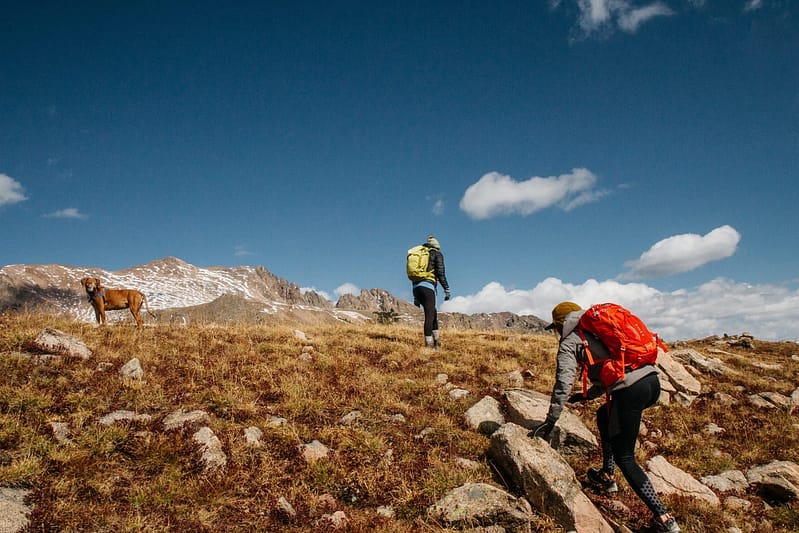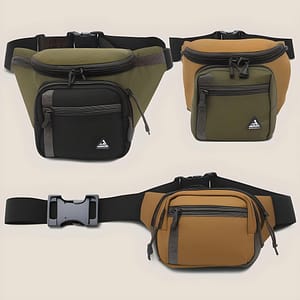When it comes to hiking, shoes are at the top of the gear checklist you need. You can compromise on all kinds of things, but when it comes to shoes, here I strongly recommend paying extra attention to choosing the right shoes. But with so many options out there, how do you choose the best ones for your needs? In this blog, we’ll explore different types of hiking shoes, factors to consider when choosing hiking and running shoes and provide recommendations for the best shoes for different terrains. Whether you’re a seasoned adventurer or just starting out on your outdoor journey, this guide will help you find the perfect pair of hiking and running shoes.
Types of Hiking Shoes
Hiking Boots: Ideal for rugged terrain and extended backpacking trips, hiking boots provide superior ankle support to prevent injuries. These boots are made with sturdy materials such as leather or synthetic fabrics, providing durability against rocks and rough trails. With their thick soles and deep lugs, they offer exceptional grip on both wet and dry surfaces.
Trail Running Shoes: I personally prefer trail running shoes. These shoes are designed for off-road running and hiking, and trail running shoes offer excellent grip on various terrains. These shoes feature aggressive tread patterns and durable outsoles that provide traction on uneven surfaces. They are lightweight and flexible, allowing for natural foot movement while offering ample cushioning for comfort during long hikes.
Did you know that approach shoes are the perfect combination of hiking shoes and climbing footwear, making them ideal for hikers who may encounter scrambling or easy rock climbing sections during their adventures? With sticky rubber soles for excellent traction on rocky surfaces and enough flexibility for comfortable walking on trails, they are a versatile choice for outdoor enthusiasts.
Approach Shoes: Combining the features of hiking shoes with climbing footwear, approach shoes are perfect for hikers who may encounter scrambling or easy rock climbing sections during their adventures. These versatile shoes have sticky rubber soles that deliver excellent traction on rocky surfaces while also providing enough flexibility for comfortable walking on trails.
1. Hiking Boots
When it comes to hiking boots, grip is essential for tackling rugged terrain. Look for boots with durable soles that provide excellent traction on both wet and dry surfaces. These boots are designed to withstand the toughest conditions and offer stability and support during long hikes.
For those who enjoy a mix of hiking and running, consider investing in hybrid shoes that combine the best features of both. These versatile shoes offer the comfort of running shoes with added durability for trail adventures. With their all-terrain capability, they are perfect for off-road exploration or hitting the trails after a run on the road.
2. Trail Running Shoes
When it comes to trail running, having the right shoes is essential for a safe and enjoyable experience. Here are some key features to look for in trail running shoes:
- Durable construction that can withstand rugged terrain
- Excellent grip on both wet and dry surfaces
- Lightweight design for agility and speed
- Cushioned midsole for comfort during long runs
- Protective toe cap to shield against rocks and debris
3. Approach Shoes
Approach shoes are a versatile option for outdoor enthusiasts who need footwear that can handle both hiking and scrambling. These shoes provide excellent grip on various terrains, including rocky surfaces and uneven trails. Their durable construction ensures long-lasting performance, making them suitable for both short hikes and longer expeditions.
Approach shoes offer the perfect balance between the comfort of hiking boots and the agility of running shoes. With their sticky rubber soles, they provide reliable traction on slippery surfaces without compromising flexibility or agility. Whether you’re tackling steep inclines or navigating tricky descents, approach shoes are a reliable choice for confident foot placement on any type of terrain, be it rugged trails or smooth roads.
Factors to Consider When Choosing Hiking and Running Shoes
There are 4 main factors: Comfort and fit, durability, traction and grip, and waterproofing. Let’s break it down :
1. Comfort and Fit
I can tolerate quite a few shortcomings in shoes, but not when it comes to comfort. My feet tend to go sideways and because of this I sometimes suffer from knee pain, so for me comfort and fit of hiking and running shoes are crucial. These shoes should have a cushioned insole that provides support and absorbs shock, reducing the impact on your feet during long hikes or runs. Additionally, a secure fit is essential to prevent blisters and ensure stability on uneven terrain. Look for shoes with adjustable lacing systems or straps that can be tightened to customize the fit according to your foot shape.
2. Durability
When it comes to durability, the best hiking and running shoes are built to withstand the toughest outdoor conditions. These shoes are made with high-quality materials that are resistant to wear and tear, ensuring they can handle rugged terrains and regular use. Additionally, they feature reinforced stitching and sturdy construction to prevent any premature damage or breakage. With their durable design, these shoes will last for years of adventures without compromising on performance.
In addition to their robust construction, the best hiking and running shoes also come equipped with protective features that further enhance their durability. This includes toe caps and heel guards that shield your feet from impact and abrasion while navigating rocky trails or uneven surfaces. Furthermore, many brands incorporate innovative technologies like rubberized outsoles or anti-shock systems that provide added protection against harsh terrains or accidental slips. With these extra measures in place, you can trust that your hiking or running shoes will remain intact throughout all your outdoor escapades.
3. Traction and Grip
When it comes to traction and grip, the right shoes can make all the difference in your outdoor adventures. Look for hiking and running shoes that feature aggressive tread patterns and rubber compounds designed for optimal grip on various terrains. Additionally, consider shoes with multidirectional lugs to enhance stability and prevent slips while navigating challenging trails or uneven surfaces. Keep in mind that a secure fit is also crucial for maintaining traction, so look for shoes with adjustable closures or lacing systems that allow you to customize the tightness around your feet.
4. Waterproofing
When it comes to waterproofing, choosing hiking and running shoes with high-quality membranes is essential. Look for options such as Gore-Tex or eVent, which provide excellent water resistance while still allowing your feet to breathe. Additionally, ensure that the shoes have sealed seams and a protective coating on the outer material to prevent water from seeping in.

Best Hiking and Running Shoes for Different Terrain
1. Mountain Trails: When it comes to conquering mountain trails, having the right footwear is crucial. Look for hiking and running shoes that offer excellent traction and stability on uneven terrain. Go for shoes with durable outsoles made of high-quality rubber compounds to ensure maximum grip on rocky surfaces. Additionally, choose shoes with supportive midsoles that provide cushioning and shock absorption to protect your feet during long hikes in challenging conditions.
2. Desert Hiking: When it comes to desert hiking, you need shoes that offer excellent protection and support. Look for shoes with a durable outsole and ample cushioning to handle the rocky terrain. Breathable materials will help keep your feet cool in hot conditions.
Additionally, Go for shoes with good traction to navigate sandy surfaces without slipping. Consider choosing lightweight options that won’t weigh you down during long hikes. Overall, prioritize comfort and functionality when selecting the best shoes for desert hiking.
3. Shoes for Wet and Slippery Trails: If you’re venturing onto wet and slippery trails, consider investing in trail running or hiking shoes specifically designed for this type of terrain. Look for models that offer aggressive tread patterns with multidirectional lugs to provide exceptional grip on slick surfaces. Choose shoes made from water-resistant materials such as Gore-Tex or treated mesh uppers to keep your feet dry during creek crossings or rainy weather. Features like integrated rock plates can also add stability while traversing rocky paths prone to slippage. Don’t underestimate the importance of proper footwear when it comes to conquering challenging wet trails; invest in quality options that prioritize traction and protection against moisture-related discomforts
Tips for Choosing the Right Hiking and Running Shoes
I have purchased quite a few hiking boots in recent years, I have made some good purchases and some less so. Here are some tips for choosing the right shoes:
1. Try on Multiple Pairs
- Don’t settle for the first pair you try; explore different options.
- Ensure a proper fit and comfort level by trying on multiple pairs.
- Consider factors such as arch support and cushioning.
When searching for the best hiking and running shoes, it’s crucial to try on multiple pairs. This allows you to find the perfect fit that offers both comfort and functionality. Consider various factors like arch support, cushioning, and the room to ensure a personalized experience tailored to your feet’s needs. Explore different options before making a decision—don’t settle for the first pair you come across!
2. Consider the Weight
Consider the Weight:
- Lighter shoes are generally more comfortable and allow for faster movement.
- Look for shoes that have lightweight materials and minimal padding to reduce weight.
- Consider the terrain you will be hiking or running on, as heavier shoes may be necessary for rough or rocky trails.
3. Break Them In
When you get a new pair of hiking or running shoes, it’s important to break them in properly to avoid discomfort and potential injuries. Start by wearing them around the house for short periods of time to allow your feet to adjust. Gradually increase the duration and intensity of your wear, incorporating short walks or light jogs before hitting the trails or pavement. This process will help mold the shoes to your feet and ensure maximum comfort during your outdoor adventures.
Consider Different Terrains
Different terrains require different shoe characteristics, so consider where you’ll be using your hiking or running shoes before making a purchase. If you’re primarily going on rocky trails, opt for shoes with sturdy soles and ankle support. On the other hand, if you’ll be running on asphalt surfaces, prioritize lightweight options with cushioning for impact absorption. By choosing shoes that are suited for specific terrains, you can enhance both performance and safety during your outdoor activities.
4. Read Reviews and Seek Recommendations
- Don’t rely solely on the product description or marketing claims; read reviews from people who have actually used the shoes.
- Seek recommendations from fellow hikers and runners, as they can provide valuable insights based on their own experiences.
Hiking in Converse?
Most of us love Converse and why wouldn’t we, they are beautiful, fashionable, and quite comfortable on a daily basis. But hiking in Converse shoes may not be the best choice for comfortable and safe hiking. Converse is not specifically designed for hiking or running on rough terrains. Here are a few reasons why you should consider other options:
1. Lack of Support: Converse shoes lack the necessary support and cushioning needed for hiking or running activities. They have a flat sole with minimal arch support, which can lead to discomfort and potential foot injuries on uneven or rocky trails.
2. Minimal Traction: Converse shoes have a smooth sole that provides minimal traction. This can be problematic when hiking on slippery or muddy surfaces, as it increases the risk of slipping and falling.
3. Durability: Converse shoes are not built to withstand the wear and tear of hiking or running activities. The canvas material used in their construction is not as durable as the materials used in specialized hiking or running shoes. This can result in premature wear and tear, reducing the lifespan of the shoes.
4. Lack of Water Resistance: Converse shoes are not designed to repel water or keep your feet dry. When hiking in wet conditions or crossing streams, your feet may become soaked, leading to discomfort and potential blisters.
If you are looking for a comfortable and safe hiking or running experience, it is recommended to invest in a pair of shoes specifically designed for these activities. Look for shoes with features such as sturdy soles, ankle support and cushioning.
Are there any specialty running and hiking shoes available for people with wider feet?
Having wider feet can often pose a challenge when it comes to finding the right fit and comfort in running and hiking shoes. Fortunately, the footwear industry recognizes this need, and there are indeed specialty shoes available for people with wider feet. There are plenty of options and features available in running and hiking shoes specifically designed to cater to individuals with wider feet. So, if you’re looking to hit the trails or conquer your running goals, keep reading to discover the right shoe fit for you.
1. Understanding Wide Feet:
Wide feet are characterized by a broader forefoot and a wider midfoot compared to the standard foot shape. It’s important to consider this unique anatomy when selecting running or hiking shoes to ensure a comfortable fit and prevent potential issues such as blisters or discomfort.
2. Key Features to Look for:
When exploring specialty running and hiking shoes for wider feet, here are some key features to consider:
a) Wide-Width Options: Several reputed shoe brands offer specific wide-width options in their product lines. These shoes are designed with a wider last, providing more room in the forefoot and midfoot areas. Look for shoes labeled as “wide” or “W” for women, and “EE” or “2E” for men.
b) Toe Box Design: The toe box refers to the area around the front portion of the shoe where the toes are located. Here are some key points to understand about toe box design:
1. Room for Toe Movement: A proper toe box design should allow for comfortable movement and splay of the toes.
2. Avoiding Toe Compression: A narrow or tight toe box can lead to compression of the toes, which can result in discomfort, blisters, and even long-term foot issues such as bunions or hammertoes.
3. Toe Protection: The toe box should also offer adequate protection for your toes while hiking or running on challenging terrains. Look for shoes with reinforced or durable materials in the toe box area to safeguard your toes from potential impacts or injuries.
4. Flexibility: While the toe box should provide ample space, it is also important for it to offer flexibility. A rigid or inflexible toe box can hinder the natural movement of your toes and limit your overall comfort and performance.
In conclusion, if you have wider feet and are in need of specialty running or hiking shoes, rest assured that there are options available. By considering factors such as shoe brands, width options, and visiting specialty stores, you can find the perfect shoes.





